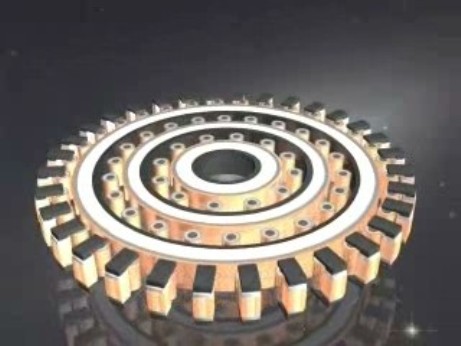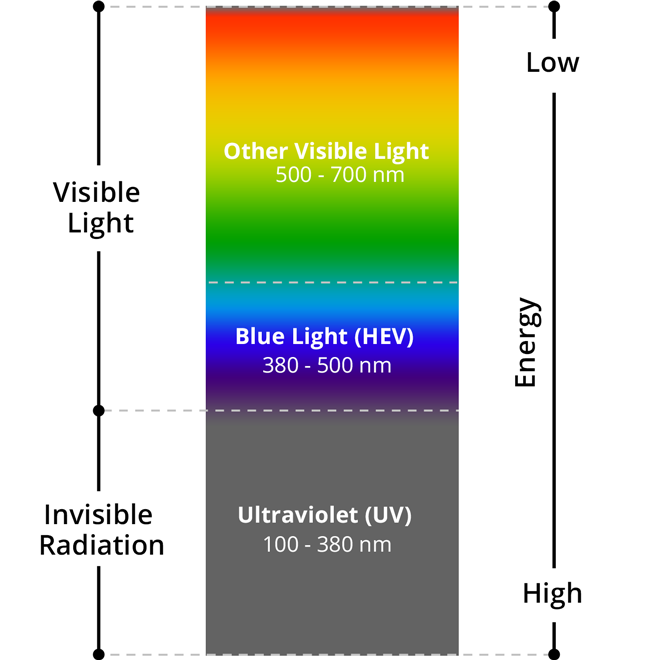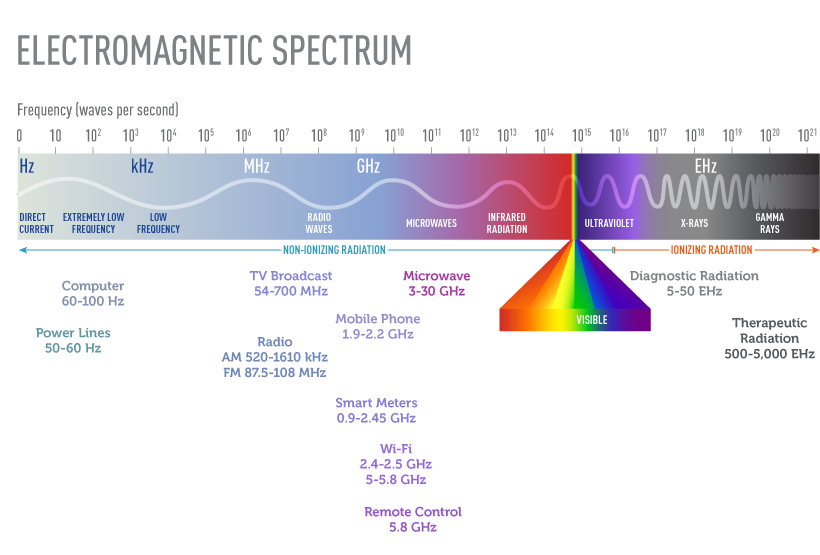Most of us spend the majority of our waking hours staring at a digital screen. Studies suggest that 60% of people spend more than 6 hours a day in front of a digital device.
What Is Blue Light?
Sunlight contains red, orange, yellow, green and blue light rays and many shades of each of these colors, depending on the energy and wavelength of the individual rays (also called electromagnetic radiation). Combined, this spectrum of colored light rays creates what we call “white light” or sunlight
Without getting into complicated physics, there is an inverse relationship between the wavelength of light rays and the amount of energy they contain. Light rays that have relatively long wavelengths contain less energy, and those with short wavelengths have more energy.
Rays on the red end of the visible light spectrum have longer wavelengths and, therefore, less energy. Rays on the blue end of the spectrum have shorter wavelengths and more energy.
The electromagnetic rays just beyond the red end of the visible light spectrum are called infrared — they are warming, but invisible. (The “warming lamps” you see keeping food warm at your local eatery emit infrared radiation. But these lamps also emit visible red light so people know they are on! The same is true for other types of heat lamps.)
On the other end of the visible light spectrum, blue light rays with the shortest wavelengths (and highest energy) are sometimes called blue-violet or violet light. This is why the invisible electromagnetic rays just beyond the visible light spectrum are called ultraviolet (UV) radiation.
Blue light is actually everywhere. When outside, light from the sun travels through the atmosphere. The shorter, high energy blue wavelengths collide with the air molecules causing blue light to scatter everywhere. This is what makes the sky look blue. In its natural form, your body uses blue light from the sun to regulate your natural sleep and wake cycles. This is known as your circadian rhythm. Blue light also helps boost alertness, heighten reaction times, elevate moods, and increase the feeling of well being. Artificial sources of blue light include electronic devices such as cell phones and laptop computers, as well as energy-efficient fluorescent bulbs and LED lights.
Why should we be concerned about blue light exposure?
Blue light waves are the among the shortest, highest energy wavelengths in the visible light spectrum. Because they are shorter, these “Blue” or High Energy Visible (HEV) wavelengths flicker more easily than longer, weaker wavelengths. This kind of flickering creates a glare that can reduce visual contrast and affect sharpness and clarity.
This flickering and glaring may be one of the reasons for eyestrain, headaches, physical and mental fatigue caused by many hours sitting in front of a computer screen or other electronic device.
Our eyes’ natural filters do not provide sufficient protection against blue light rays from the sun, let alone the blue light emanating from these devices or from blue light emitted from fluorescent-light tubes. Prolonged exposure to blue light may cause retinal damage and contribute to age-related macular degeneration, which can lead to loss of vision.
The evolution in digital screen technology has advanced dramatically over the years, and many of today’s electronic devices use LED backlight technology to help enhance screen brightness and clarity. These LEDs emit very strong blue light waves. Cell phones, computers, tablets and flat-screen televisions are just among a few of the devices that use this technology. Because of their widespread use and increasing popularity, we are gradually being exposed to more and more sources of blue light and for longer periods of time.
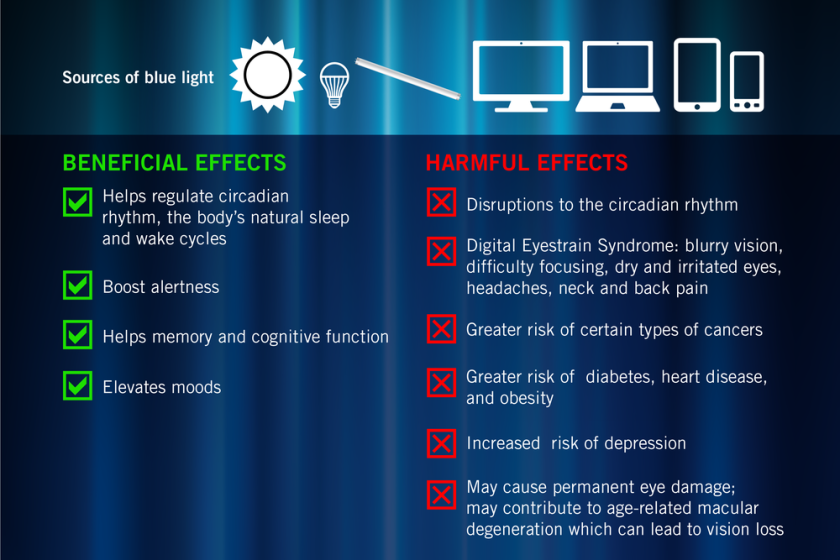
Blue light can help elevate your mood and boost awareness, but chronic exposure to blue light at night can lower the production of melatonin, the hormone that regulates sleep, and disrupt your circadian rhythm.
Harvard researchers have linked working the night shift and exposure to blue light at night to several types of cancer (breast, prostate) diabetes, heart disease, obesity and an increased risk for depression.
Researchers aren’t exactly sure why exposure to blue light at night seems to have such detrimental effects on our health, but it is known that exposure to light suppresses the secretion of melatonin and lower melatonin levels might explain the association with these types of health problems.
Even though blue light is nothing new, the biggest issue is the amount of blue light exposure that we get each day through digital device use. With this exposure increasing over time, we are actually causing permanent damage to our eyes.
Children are especially at risk when it comes to the negative effects of blue light exposure. These days, a lot of homework is done online, and many children have access to (or have their own) digital devices that they are using for increasingly longer periods of time. The difference for children is that their eyes are still developing, and they don’t yet have the protective pigments in their eyes to help filter out some of this harmful blue light. That’s why, just like with UV radiation, most blue light exposure occurs before kids are 18 years old.
While it may be a great concern for children, adults are susceptible, as well. This is especially true as adults are using digital devices more and more in both their personal and professional lives. So what can you do about it?
First, you can take steps to protect your eyes from the harmful effects of blue light. If you’re not able to limit your digital device use, at least cut back on it before bed. Studies show that exposure to blue light a couple of hours before bedtime actually suppresses melatonin and delays deep REM sleep significantly. So cutting back on tech use at night means getting better sleep, making people more productive at both work and school (and speaking from my own personal experience, it makes children more pleasant).
Second, you should consider talking with your eye doctor about lenses that filter out blue light (and no, these aren’t the old bright orange blue-blocker eyewear from the ‘90s). The lenses have little-to-no tint and can help to minimize the direct blue light exposure that you get throughout the day. Most of my patients who have these lenses noticed an immediate increase in eye comfort because of the improved contrast, which helps to relax the eyes. And if you have children, I would absolutely recommend these lenses — especially if they have trouble sleeping at night.
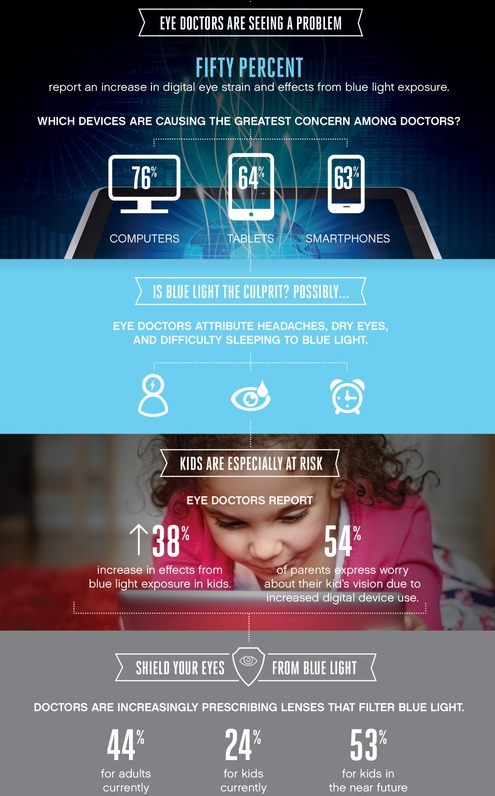
By keeping in mind a few simple ways to protect the eyes, we can take pleasure in knowing that our eyes will last much longer than our trusty smartphones, tablets and computers.

